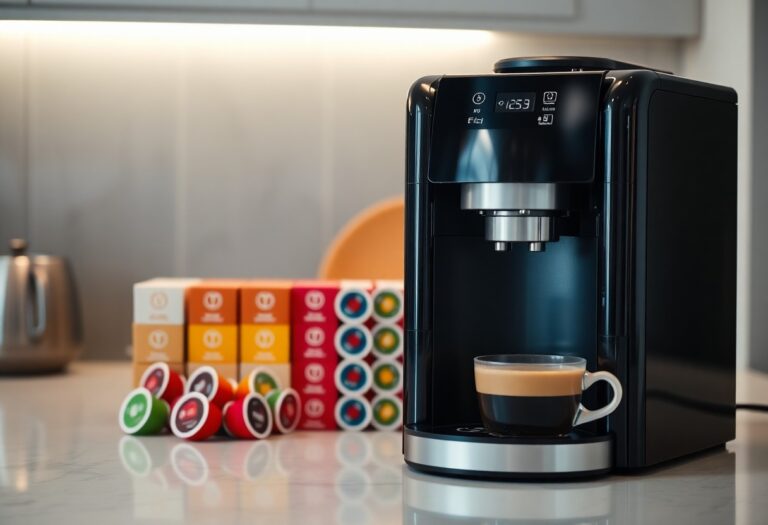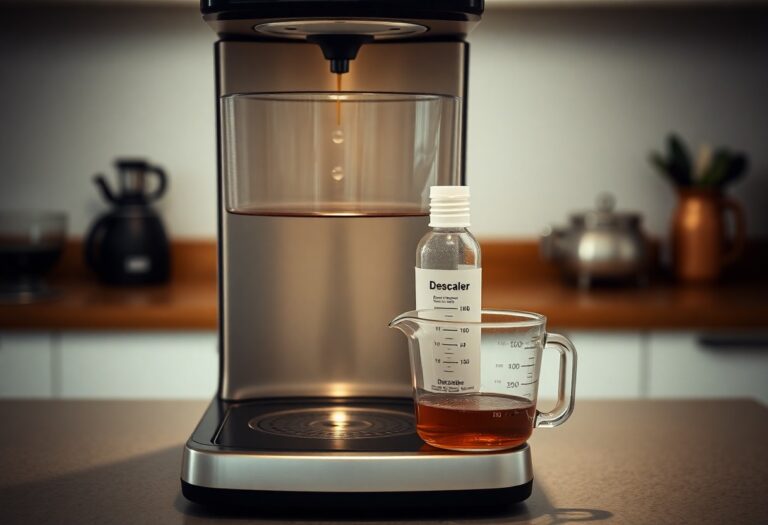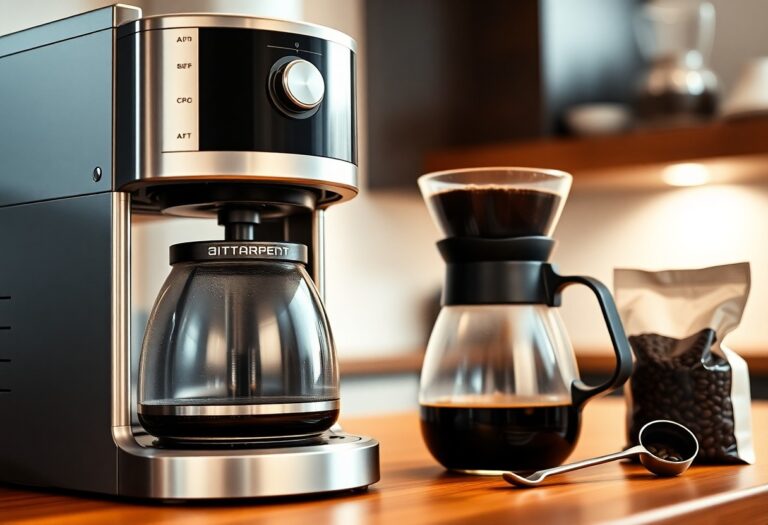What is Coffee Machine Descaler Made Of – Chemical Composition
It’s necessary to understand what coffee machine descaler is made of to effectively maintain your equipment. Typically, descalers consist of acidic compounds such as citric acid or acetic acid, which help dissolve mineral build-up from your machine. These acids are effective in removing limescale and other deposits, ensuring optimal performance and flavor in your brews. While these chemicals are generally safe, always handle them with care and follow manufacturer guidelines to protect both your health and your coffee machine.
Key Takeaways:
- Coffee machine descalers are typically made from acids, such as citric acid or lactic acid, which effectively dissolve mineral buildup.
- Some descalers may use sulfamic acid, a strong acid that targets hard water deposits and is effective for tough scaling.
- Many commercial descalers include surfactants that help enhance the cleaning process by breaking down residues.
- Natural descalers often contain ingredients such as vinegar or baking soda, which are less aggressive but can still be effective against scale.
- It’s important to check the pH level of the descaler to ensure it’s safe for use with your coffee machine, as overly acidic solutions can damage components.
Decoding the Ingredients: What Constitutes Coffee Machine Descaler?
Coffee machine descalers are formulated with specific ingredients to tackle the scaling and buildup that can occur in appliances over time. Understanding the components of these descalers helps you choose the right product for effective maintenance of your machine. Each ingredient plays a distinctive role, ensuring that your coffee-making experience remains uninterrupted by mineral deposits.
Primary Active Components
The primary active components of coffee machine descalers are typically organic acids like citric acid and lactic acid. These naturally occurring acids are renowned for their effectiveness in breaking down mineral deposits such as calcium and magnesium, which accumulate due to hard water. A product high in these acids can significantly reduce scale buildup, ensuring your coffee machine operates at optimal efficiency.
Secondary Additives and Their Roles
Besides the primary active components, coffee machine descalers often include secondary additives that enhance the effectiveness of the product. These might consist of surfactants and preservatives that improve the corrosion inhibition properties and shelf life of the descaler. By employing these additives, manufacturers ensure that the descaler not only removes limescale but also protects your machine from potential damage.
Surfactants, for instance, facilitate better penetration of the descaler into crevices and hard-to-reach areas, ensuring a more thorough cleaning process. Preservatives help maintain the product’s effectiveness over time, allowing you to store the descaler without concerns about it losing potency. Additionally, some formulations may include fragrances or colorants to improve user experience, making maintenance less of a chore. Overall, these secondary ingredients amplify the primary acids’ performance, making the descaling process more efficient and user-friendly.
The Chemistry Behind Coffee Machine Descaling
Understanding the chemistry behind coffee machine descaling enhances your appreciation for this necessary maintenance task. At its core, the descaling process involves breaking down mineral deposits like calcium and lime that accumulate in your coffee machine over time. The effectiveness of descalers hinges not only on their acidic ingredients but also on various other components that work synergistically to restore your machine’s optimal performance and extend its lifespan.
How Acids Work to Remove Mineral Buildup
Acids, such as citric and lactic acid, play a pivotal role in dissolving mineral buildup in your coffee machine. When these acids come into contact with calcium carbonate, they initiate a chemical reaction that produces soluble calcium ions and carbon dioxide gas. The reaction effectively removes limescale, ensuring your coffee machine operates smoothly and efficiently, leading to better-tasting brews.
The Role of Chelating Agents in Descaling
Chelating agents are key players in the descaling process, as they bind to mineral ions, enhancing their solubility and preventing them from re-depositing in your machine. Common chelators include EDTA and other synthetic compounds, which effectively trap minerals, making it easier for them to be washed away during the descaling cycle. This dual-action approach not only improves overall cleanliness but also safeguards the internal components of your coffee maker.
Incorporating chelating agents into your descaler not only increases its efficiency but also prolongs the effectiveness of your cleaning regimen. When these agents bind to mineral ions, they prevent the ions from crystallizing or reattaching to surfaces, reducing the frequency of maintenance required. Moreover, this prevents potential damage caused by mineral deposits, ultimately leading to longer equipment life and consistently better brewing results. You’ll find that options combining these agents are particularly effective for hard water areas, ensuring your coffee remains pure and flavorful.
Environmental Impact of Descaling Agents
The environmental implications of coffee machine descalers vary significantly based on their composition. While some commercial products may contain harmful chemicals that can adversely affect aquatic ecosystems, eco-friendly options are increasingly popular. These alternatives often utilize biodegradable ingredients, significantly reducing their environmental footprint. Selecting a descaler with a lower environmental impact ensures you’re not only maintaining your coffee machine but also safeguarding the planet.
Biodegradability and Safety Concerns
Many commercial descalers contain harmful chemicals, raising safety concerns for both users and the environment. Alternatives, primarily those based on citric acid or lactic acid, tend to be more biodegradable and less toxic. While these formulations effectively combat mineral buildup, they also mitigate the risks associated with environmental contamination and exposure to hazardous substances.
Comparison of Commercial vs. Homemade Descalers
When evaluating descalers, you can choose from commercial products or create homemade solutions. The benefits of homemade descalers often include lower cost and greater control over ingredients. However, commercial descalers may offer formulated solutions tailored for optimal performance. The decision ultimately hinges on your preferences for convenience versus the desire for natural ingredients.
| Commercial Descalers | Homemade Descalers |
| Designed specifically for descaling | Common ingredients are cost-effective |
| Potentially contains harsh chemicals | Often uses natural acid sources |
| Convenience of purchase and use | Allows for ingredient control and customization |
When assessing the efficacy of commercial versus homemade descalers, consider factors like effectiveness and convenience. Commercial descalers often deliver dependable results due to their specialized formulations, targeting stubborn mineral deposits with precision. Conversely, homemade solutions utilizing vinegar, lemon juice, or citric acid can be effective yet may require more effort and trial-and-error to achieve similar results. Ultimately, aligning your choice with your values and needs ensures your coffee machine remains in peak condition.

Practical Application: When and How to Use Descalers Effectively
Utilizing a descaler should be part of your regular coffee machine maintenance routine. Typically, it’s advised to descale your machine every three to six months, depending on the hardness of your water and frequency of use. Follow product instructions for optimal results. For guidance on the difference between cleaning and descaling a coffee machine, ensure you understand the unique processes involved in maintaining your equipment.
Frequency of Descaling for Optimal Performance
Descaling frequency directly impacts your coffee machine’s efficiency and lifespan. If your water is hard, you should aim for descaling every one to three months. Softer water allows for more flexibility, extending this interval up to six months. Regular descaling prevents mineral buildup, maintaining optimal extraction and flavor.
Step-by-Step Guide to Descaling Your Coffee Machine
Follow these key steps to effectively descale your coffee machine:
| 1. Obtain a suitable descaler | Purchase a food-safe or manufacturer-recommended descaler. |
| 2. Prepare the machine | Empty the water reservoir and remove any used coffee grounds. |
| 3. Mix descaler with water | Follow instructions for mixing the solution in the reservoir. |
| 4. Start the descaling cycle | Run the machine as if brewing coffee, allowing the solution to flow through. |
| 5. Rinse thoroughly | Run several cycles with clean water to eliminate any residue. |
After completing these steps, ensure you empty the carafe and rinse the components, as this will prevent any leftover descaler from affecting your next brew. For optimum results, use fresh water for rinsing and allow the machine to rest for a few hours after descaling before using it again. Regular adherence to this descaling process will keep your coffee machine functioning optimally, enhancing the quality of every cup brewed.

Choosing the Right Descaler: What to Look For
Selecting the appropriate descaler for your coffee machine involves understanding both the product’s composition and its compatibility with your device. Look for descalers that effectively combat mineral buildup without damaging internal components. Consider the type of scaling issue you’re facing and ensure the chosen descaler is tailored to those specific needs, enhancing your machine’s performance and lifespan.
Reviewing Product Labels: Key Information
Examining product labels provides vital information on the descaler’s active ingredients and usage instructions. Look for specific mentions of acids, such as citric or phosphoric acid, which indicate effective scaling properties. Additionally, pay attention to any safety warnings, recommended dilutions, and suitability for your particular coffee machine to ensure safe and efficient use.
Cost vs. Efficacy: Making Informed Choices
Evaluating the balance between cost and efficacy can significantly impact your descaling decisions. While lower-priced options may seem appealing, it’s necessary to consider their effectiveness against mineral buildup compared to higher-priced, well-reviewed products.
Cost versus efficacy entails weighing the long-term benefits of a product against its initial price. A cheaper descaler may require more frequent applications, ultimately leading to higher expenses over time. For instance, investing in a descaler that effectively removes stubborn limescale can save you from potential damage and performance issues down the road. Prioritize products with strong reviews and proven results, ensuring your choice enhances the longevity of your coffee machine while keeping costs manageable.
Summing up
Conclusively, understanding the chemical composition of coffee machine descalers is important for effective maintenance. You will typically find citric acid, lactic acid, and other mild acids in these products, which help dissolve mineral build-up without harming your machine. By choosing a reliable option, such as a Citric Acid Descaler, you can ensure your coffee maker operates smoothly and brews great-tasting coffee. Keeping your machine clean will not only enhance your coffee experience but also prolong its lifespan.
FAQ
Q: What is the primary component of coffee machine descaler?
A: The primary component of most coffee machine descalers is usually citric acid. Citric acid is a natural substance found in citrus fruits and is effective at breaking down limescale and mineral deposits that can accumulate in coffee machines over time.
Q: Are there any other chemicals commonly found in descalers?
A: Yes, in addition to citric acid, many commercial descalers contain lactic acid, acetic acid, or sulfamic acid. Each of these acids has its own properties and effectiveness in dissolving mineral build-up, making them popular choices for formulations.
Q: Is it safe to use coffee machine descalers on all types of machines?
A: Most coffee machine descalers are formulated to be safe for use on a variety of machines, including espresso makers and drip coffee makers. However, it is important to check the manufacturer’s recommendations and avoid using descalers that contain harsh chemicals, like phosphoric acid, on certain machines or materials that could be damaged.
Q: How often should coffee machine descaler be used?
A: The frequency of descaling can depend on water hardness and how often the machine is used. Generally, it is advisable to descale every 1 to 3 months to maintain efficiency and flavor. Checking the manufacturer’s guidelines can provide specific recommendations for your machine.
Q: Can I make a homemade descaler for my coffee machine?
A: Yes, you can create a homemade descaler using simple ingredients like vinegar or lemon juice diluted with water. While this method can be effective, it may not work as swiftly as commercial descalers, and it’s important to rinse the machine thoroughly afterward to avoid any residual flavors.







